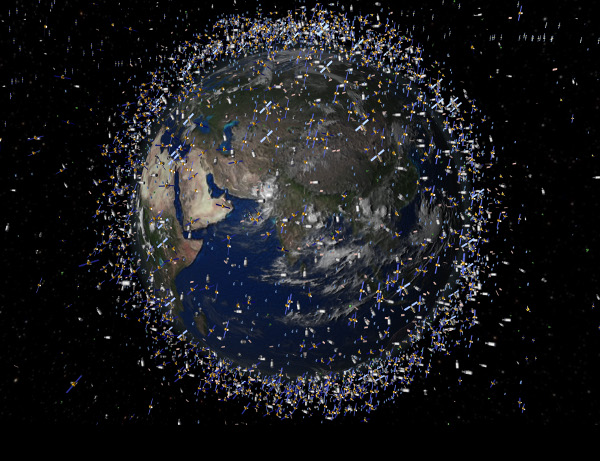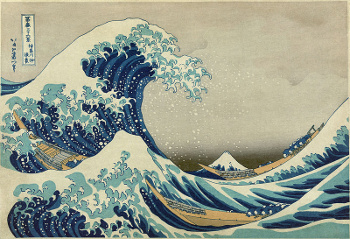The Kessler Syndrome
March 3, 2011
Outer space is a dangerous place. Even here, at
Earth's surface, we need to worry about
extraterrestrial fallout in the form of rogue
meteors and
coronal mass ejections, among other things. Life in Earth orbit is even more hazardous, because of all the debris. As I reviewed in a
previous article (Danger, Will Robinson! August 31, 2010), early
satellites did not have the capability to de-orbit after their useful life, and some newer satellites enter orbit dead-on-arrival, so their controlled descent capability cannot be activated.
NASA and other space agencies have been looking at ways to remove unwanted satellites, and the occasional rouge
booster rocket, from orbit. One system, called GOLD, for Gossamer Orbit Lowering Device, looks to attach space balloons to unwanted craft to increase
aerodynamic drag of orbiting craft so they will de-orbit naturally at a hundred-fold faster rate.[1] Such balloons could be attached to the larger pieces of space junk by a
robot craft.

Satellites in Low Earth Orbit (European Space Agency)
Unusual concepts, such as this space balloon system, have been discussed over the years, and news outlets like stories with a baseline margin of strangeness. That's probably why an article about using
fishing nets to catch satellites stormed the internet in early February of this year.[2] The original source article was in the
Telegraph, a UK news source I read regularly on the Internet since the articles are well written. However, when this article hit the web, I didn't report on it. The reason is I had at one time
brainstormed with a team about possible ways to capture and de-orbit debris, and I had learned a lot about the technical challenges. The fishnet idea seemed too strange, even for me.
The story had a wealth of public interest. The agency supposedly working on the space net was the
Japan Aerospace Exploration Agency (JAXA). It was said to have teamed with a Japanese fishing net manufacturer, Nitto Seimo Company, on the development, and they had actually built such a net.[2] We all associate Japan with seafaring and
sushi, so all this made sense. Nitto Seimo has been in the net business for quite some time, having invented a machine to make knotless fishing nets in 1925. The space net would be made of alloy fibers that would expand to an area of several square
kilometers in space. It supposedly would float in orbit, collecting debris, and would naturally de-orbit.[2]
Unfortunately, the Japan Aerospace Exploration Agency disavows any knowledge of this scheme.[3] Eisuke Aizawa of JAXA, confirming that his agency is not working on this idea, is quoted in
Science as saying,
"It's a bit of a bother. We're getting a lot of inquiries from overseas asking if it's true"
So, how does a story like this happen? The first ingredient, of course, is that it's so cute, you want to believe. The story likely had its genesis in some Japanese language articles that had a gem of truth, but they were distorted over time and then translated. The space net sounds a lot like a concept by
Jerome Pearson to use smaller-sized nets for the same purpose.[4] Someone must have proposed the larger space net idea, but it was discarded after careful analysis. There is the problem that space debris doesn't just float there in space waiting to get scooped-up by a giant net. Although close objects in the same
orbit appear stationary to each other, orbits aren't nice
circles, and an object in a highly
elliptical orbit can whiz by and tear through your net.
It was reported in 2007 that the US was tracking 10,000 orbital objects that are at least four inches in dimension.[5] A 2010 estimate of objects of all sizes in Earth orbit was 370,000,[2] so the chances of getting hit by something is getting rather large. The
Russian Kosmos 2251, a retired
communications satellite, destroyed the functional
Iridium 33 communications satellite on February 10, 2009.[4] The consequence of
this impact was not limited to the loss of one functional satellite. This collision, at an impact velocity of 11.6 km/sec, generated hundreds of large fragments and many thousands of smaller fragments, all of which can impact other satellites in the future.[5]
This leads to a possible Earth orbit scenario called the
Kessler syndrome, named for
Donald J. Kessler, a former head of the
NASA orbital debris program. We've all seen
mousetrap demonstrations of
nuclear fission, and many of these can be found on YouTube.[6] One event triggers several others, that trigger several others, etc. That was Kessler's idea, that there might come a time when Earth orbit will be too hazardous for anything, since a
chain reaction of satellites smashing each other has destroyed everything in orbit, leaving a sea of high velocity debris.
As if the present situation wasn't bad enough, there have been
anti-satellite weapon tests that have reduced single intact satellites to streams of many small objects.[7] Perhaps we should try to make those space nets work.

Cast those space nets!
"The Great Wave off Kanagawa," Japanese color woodblock print
(c. 1826-1833).
![]()
References:
- Space Daily, "Safe And Efficient De-Orbit Of Space Junk Without Making The Problem Worse," August 3, 2010.
- Danielle Demetriou and Peter Hutchison, "'Fishing net' to collect space debris," Telegraph (UK), February 2, 2011.
- News of the Week: Around the World, Science, vol. 331, no. 6018 (February 11, 2011), pp. 654-655.
- Evan I. Schwartz, "The Looming Space Junk Crisis: It's Time to Take Out the Trash," Wired, May 24, 2010.
- Donald J. Kessler, "The Kessler Syndrome," March 8, 2009.
- A Lab Representation Of Nuclear Fission (YouTube video).
- William J. Broad, "Orbiting Junk, Once a Nuisance, Is Now a Threat," The New York Times, February 6, 2007.
Permanent Link to this article
Linked Keywords: Outer space; Earth; extraterrestrial; meteor; coronal mass ejection; satellite; NASA; booster rocket; aerodynamic drag; robot; Satellites in Low Earth Orbit; European Space Agency; fishing net; Telegraph; brainstorming; Japan Aerospace Exploration Agency; JAXA; sushi; kilometer; Science; Jerome Pearson; orbit; circle; elliptical orbit; Russian Kosmos 2251; communications satellite; Iridium 33 communications satellite; 2009 satellite collision; Kessler syndrome; Donald J. Kessler; NASA orbital debris program; mousetrap; nuclear fission; chain reaction; anti-satellite weapon; "The Great Wave off Kanagawa," Japanese color woodblock print.